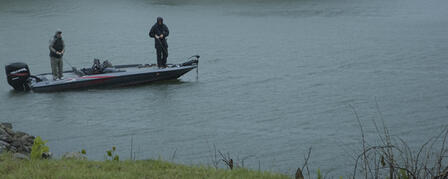KDWPT FISHING FORECAST NOW ONLINE

Feb. 1, 2012
2012 statewide summary helps anglers find best spots to fish
PRATT — Each year, the Kansas Department of Wildlife, Parks and Tourism (KDWPT) prepares the Kansas Fishing Forecast, an indispensable tool that forecasts fishing prospects in public waters throughout the state.
The 2012 Kansas Fishing Forecast, now online at www.kdwpt.state.ks.us (click Fishing/Fishing Forecast), assembles results of biologists' sampling efforts into a format that can help anglers select lakes that will most likely provide the best opportunity to catch the kind and size of fish they prefer. The information is formulated from data collected by fisheries management biologists through annual lake monitoring, which includes test netting and electroshocking.
Water bodies are separated into three categories — reservoirs (waters larger than 1,200 acres), lakes (waters from 10 to 1,200 acres), and ponds (waters smaller than 10 acres). This helps anglers understand that while a water body may have a high rating, if it is small, its overall opportunity may be limited.
Table categories have been created for popular species and include a Density Rating, Preferred Rating, Lunker Rating, Biggest Fish (the largest fish taken in sampling), Biologist’s Rating, and Three-Year Average. The Three-Year Average rating is included because not every lake can be survey every year.
The Density Rating is the number of high-quality size or larger fish per unit of sampling effort. High-quality size, listed in parentheses at the top of the Density Rating column, is the length of fish considered acceptable to most anglers and is different for each species. The higher the Density Rating, the more high-quality sized or larger fish per surface acre in the lake. Theoretically, a lake with a Density Rating of 30 has twice as many high-quality sized fish per acre as a lake with a Density Rating of 15.
The Preferred Rating identifies how many above-average-sized fish a water contains. For example, a lake may have a good density of crappie, but few fish over 10 inches. The Preferred Rating helps anglers select which lake to go to for a chance to catch bigger fish.
The Lunker Rating is similar to the Density Rating, but it indicates the relative density of lunker-sized fish in the lake. A lunker is a certain length of fish considered a trophy by most anglers. It also differs with each species and is listed in parentheses at the top of the Lunker Rating column. For example, most anglers consider a channel catfish longer than 28 inches a lunker. Many lakes may have a lunker rating of 0, but this does not mean there are no big fish in that lake. It just means that no lunker fish were caught during sampling, and they may be less abundant than in lakes with positive Lunker Ratings.
Anglers can use the Density Rating and Lunker Rating together. For those who want numbers, go with the highest Density Rating. For those who want only big fish, go with the Lunker Rating. Somewhere in the middle might be a better choice. A lake with a respectable rating in all three categories should provide the best overall fishing opportunities.
The Biggest Fish column lists the weight of the largest fish caught during sampling. A heavy fish listed here can give the lunker angler confidence that truly big fish are present.
The Biologist’s Rating adds a human touch to the forecast. Each district fisheries biologist reviews the data from annual sampling of their assigned lakes. This review considers environmental conditions that may have affected the sampling. They also consider previous years’ data. A rating of P (poor), F (fair), G (good), or E (excellent) will be in the last column. Sometimes the Density Rating may not agree with the Biologist’s Rating. This will happen occasionally and means the Density Rating may not accurately reflect the biologist’s opinion of the fishery.
Printed copies of the forecast will be available at KDWP offices by the end of February, and the March/April issue of Kansas Wildlife & Parks magazine will present the forecast as a full-color article. (For subscriptions, phone 1-800-288-8387.)
Whether the angler is after big fish or more fish, the forecast will help find them. Weekly reports on fishing conditions at waters throughout the state are also posted on the website and complement the forecast.
-30-









